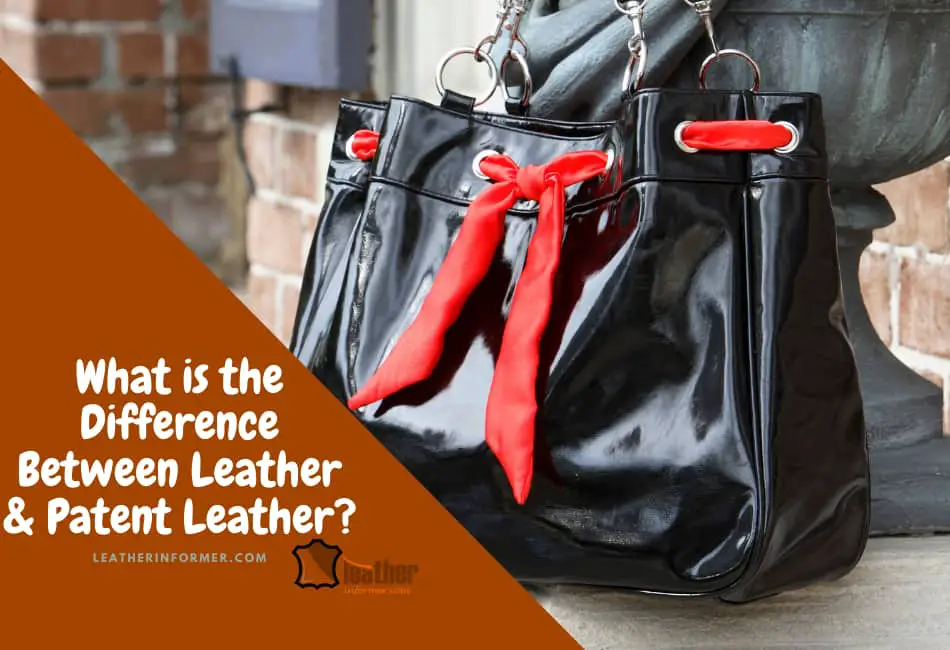The term leather is a generic word that covers a variety of materials, including those that come from the skins of animals and synthetic materials.
This sometimes makes it difficult to differentiate between the two based on the context clues. For example, faux leather is an artificial product that looks and feels like animal skin without using actual animal products.
On the other hand, patent leather will always be made from animal skin treated with a polymer coating. The result is a glossy, shiny surface that looks much like plastic. This difference in appearance and texture sets patent leather apart from regular leather.
Patent leather was first created in the early 19th century to produce a more durable and waterproof material for shoes and other items.
Creating patent leather involves adding multiple layers of lacquer or varnish to the surface of the leather. This gives it a smooth and hard finish that is easy to clean and maintain.
One of the benefits of patent leather is that it does not show scratches as easily as regular leather. However, it is also more susceptible to cracking and peeling over time if it is not properly cared for.
So, if you’re looking for a simple way to differentiate between leather and patent leather, remember that the latter is a type of leather that has been treated with a polymer coating to create a shiny, smooth surface.
Patent leather is more durable and easy to clean but can also be more susceptible to cracking over time than leather.
Leather vs. Patent Leather: How To Tell The Difference
Many things set these two materials apart, and I will discuss each in more detail in the rest of the article. So, let’s get started! I will be comparing leather and patent leather based on the following;
1. Price
Leather is typically more expensive than patent leather. In addition, although both patent leather and leather materials are sourced from the skins of animals, the leather’s quality is very different from that of patent leather.
Patent leather is made from lower-quality cuts of animal skin, which is why it costs less. Unfortunately, the lower quality of the skin also means that patent leather will often not be as durable as regular leather.
Generally, severely blemished or scratched leather will be finished into patent leather, while top-quality animal hides and skins will be used for leather.
Next, let’s take a look at the appearance of each material.
2. Appearance
The appearance of patent leather and leather are the easiest ways to tell them apart. Patent leather has a high shine and an almost wet look to it that is caused by a coating of plastic.
This gives patent leather its name; the word “patent” refers to this type of glossy finish.
Leather, on the other hand, has a more natural matte finish. In addition, leather can be treated with oil or wax to give it a shine, but this is not the same high-gloss shine you will see on patent leather.
The advantage of the appearance of leather over leather is that it does not show scratches as easily.
Now that we have looked at price and appearance let’s move on to durability.
3. Feel
Leather has a more natural feel to it because it is a porous material. This means it can absorb moisture, making it more comfortable to wear in hot weather. Patent leather, however, is glossy, non-porous, and does not absorb moisture.
In addition, patent leather is often stiffer than regular leather, making it less comfortable to wear when compared to leather.
To conclude on this point, leather has a more natural feel, while patent leather has a more glossy synthetic feel.
4. Type Of Smell
The type of smell you get with patent leather and leather is also quite different. Patent leather has a strong chemical smell because of the plastic coating that is applied to it.
On the other hand, leather has a more natural smell because it is an organic material. The smell of leather is generally influenced by the tanning method, dyes, and finishes that are used on it.
While certain types of leather will have a stronger smell than others, the smell of leather is generally not as strong as the chemical smell of patent leather – especially when they are new.
So, if you have both materials at hand and are trying to figure out which one is, you can take a quick sniff test.
5. Breathability
Leather is a much more breathable material than patent leather. This means that it will absorb and release sweat much better than patent leather, making it a more comfortable material to wear in hot weather.
Patent leather, however, does not absorb sweat well and can make your feet feel hot and sweaty in warm weather.
To check the materials’ breathability, you can do a quick “water droplet test.” Place a water droplet on each material, and see how long it takes for the water to evaporate.
You will notice that the water droplet sits on top of patent leather and takes much longer to evaporate than it does on leather.
6. Water Resistance
Leather is not a waterproof material; it will absorb water if wet. This means that leather shoes are not the best choice for rainy days or snow.
Patent leather, on the other hand, is more water-resistant because of the plastic coating that is applied to it.
So, patent leather is the way to go if you are looking for a material that is more resistant to water.
7. Scratch Resistance
Due to the glossy nature of patent leather, it shows scratches and scuff marks easily. However, leather is more forgiving in this respect as scratches can be buffed out or will eventually blend in with the natural aging of the material.
So you’re likely to see a lot more scratches on patent leather than on leather – especially if subjected to a lot of wear.
8. Wrinkle Resistance
Patent leather is generally more wrinkle-resistant than leather. This is because the plastic coating on patent leather prevents it from wrinkling as easily as leather. However, both materials will eventually show wrinkles with age and wear.
Between both materials, patent leather will take longer to show wrinkles, but its wrinkles will be brutal when they do appear. On the other hand, leather will show wrinkles sooner, but they will be more subtle and, in most cases, should be easier to remove creases from leather than patent leather.
So take a closer look at both materials, and if you see wrinkles, even if the items are new, chances are they’re made of leather.
9. Stain Resistance
Patent leather is generally more stain-resistant than leather because of the plastic coating that is applied to it. This means that patent leather is less likely to absorb spills and stains than leather.
However, both materials are susceptible to staining if not cleaned properly and in a timely manner. So be sure to clean up any spills or stains as soon as possible, regardless of the materials.
10. Maintenance
Patent leather requires less maintenance than leather. This is because the plastic coating on patent leather protects it from dirt and debris.
Leather, on the other hand, needs to be conditioned regularly to prevent it from drying out and cracking.
So, patent leather is the way to go if you are looking for a low-maintenance material.
Final Thoughts
All in all, leather and patent leather are two very different materials. They differ in smell, breathability, water resistance, scratch resistance, wrinkle resistance, stain resistance, and maintenance.
So, when deciding between the two materials, be sure to keep all of these factors in mind to make the best decision for you. Thanks for reading! I hope this article was helpful.

